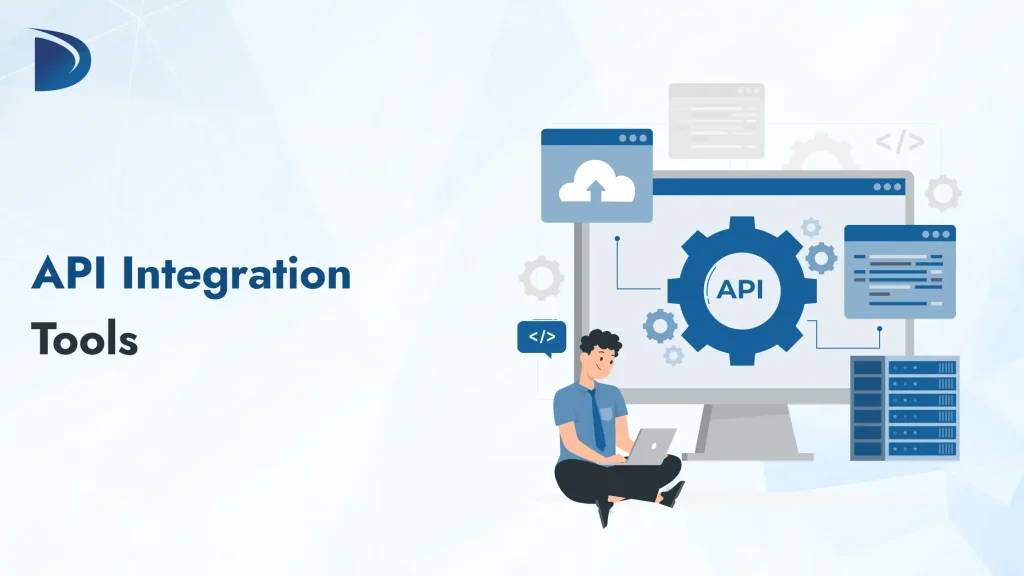Table of Contents
Tech stacks today are a bit like wild animals. You’ve got tools for sales, marketing, finance, and customer support, each doing its own thing, rarely playing nice with the other. And real chaos happens when you try to make them talk.
That is exactly why API integration tools matter. They’re the heroes, quietly connecting the dots between your platforms so your business doesn’t have to run on spreadsheets and good prayers.
With the right API connector software, your applications sync up, your data flows smoothly, and your team stops wasting time jumping between tabs. This is about building an ecosystem that’s adaptable, scalable, and ready for whatever you throw at it next.
In this blog, we’ll study how API integration platforms work, what makes a good API integration solution, and why choosing the best API integration platform could be the smartest decision you make for your business this year.
Understanding API Integration Tools
What Is an API?
An API defines how two software systems communicate. It allows platforms to request and exchange data in a consistent, structured way. APIs are what enable your CRM to send updates to your email platform or your accounting system to pull data from your sales app.
Why Integration Tools Are Necessary
While APIs create the possibility of connection, they don’t manage it. Most software applications have their own distinctive formats, policies, and security layers. Connecting them manually is lengthy, expensive, and hard to scale.
That is where they come in. They handle these technical hurdles, helping businesses link applications, automate pipelines, and lessen the need for manual data entry.
Why Businesses Rely on API Integration Tools Today
The Software Stack Has Exploded
Today’s companies don’t use one or two tools, they use dozens. CRMs, ERPs, eCommerce platforms, support systems, data warehouses, analytics dashboards; the list keeps expanding. Each of these tools holds important data, but most aren’t crafted to talk to each other out of the box.
That’s where API integration software becomes critical. It creates a communication layer between platforms so that data doesn’t just sit in silos. It moves, updates, and reflects reality across systems.
Manual Work Is Slowing Businesses Down
When systems aren’t integrated, employees become connectors. They copy data from one app and paste it into another. They chase down updates, re-enter records, fix mismatches, and lose hours every week doing work that should’ve been automated.
A reliable API solution removes this inefficiency. It allows real-time syncing between systems, reducing manual effort, human error, and duplicated work.
Teams Need Clean, Centralized Data
Fragmented data leads to faulty decisions. If sales, marketing, and finance are all working with different numbers, order is impossible.
With the correct API integration platform, data can flow into a central system accurately and consistently. That creates a single source of truth and unlocks better analytics, faster reporting, and stronger collaboration across teams.
Integration Is No Longer Optional
Digital transformation is a reality of today. From startups to enterprises, integration is no longer a “nice-to-have.” It’s the infrastructure that keeps businesses agile, competitive, and customer focused.
Choosing the best API integration platform isn’t just about connecting systems. It’s about enabling innovation, streamlining operations, and building the kind of agility that modern businesses depend on.
Key Capabilities of Powerful API Integration Tools
Pre-Built Connectors That Actually Save Time
A strong API integration platform should offer a rich library of pre-built connectors for commonly used apps such as Salesforce, HubSpot, Stripe, Shopify, NetSuite, and so on. These connectors drastically reduce development time and allow teams to launch integrations faster, without reinventing the wheel every time.
This kind of plug-and-play flexibility is essential for teams that want speed without sacrificing stability.
Data Mapping and Transformation
Raw data doesn’t always travel well. What one system calls “Customer ID,” another might call “Client Reference.” Powerful API integration software should allow you to map data fields between systems and apply transformations on the fly.
That ensures that your data arrives where it needs to be, clean, structured, and usable.
Built-In Error Handling and Monitoring
Things break. APIs time out. Servers go down. Data formats change. A capable API solution should come with built-in monitoring, logging, and error-handling mechanisms that notify your team immediately, and can retry or reroute failed operations.
You’re not just integrating systems. You’re managing the risk of failure.
Role-Based Access and Security Controls
Security is non-negotiable. A solid API integration platform should support encryption, token-based authentication, audit trails, and role-based access controls, especially when sensitive data is moving between internal and external systems.
Compliance starts with having the right guardrails in place.
Scalability and Flexibility
The best API integration platform isn’t just right for you today; it’s built to scale with your business. From adding more users, expanding across regions, or adopting new tools, your integration layer should adapt without a complete overhaul.
Low-Code or No-Code Interfaces
While some integrations need custom scripting, many don’t. A modern platform should offer intuitive, drag-and-drop tools so business users and non-engineers can create and manage workflows confidently.
That lowers IT dependency and speeds up iteration.
Popular Use Cases Across Industries
| Industry | How API Integration Tools Are Used | Value Delivered |
| Retail & eCommerce | Connect eCommerce platforms, POS systems, CRMs, and ERPs using powerful API tools and API integration platforms. | Real-time inventory sync, faster fulfillment, and improved customer experience. |
| Finance & Banking | Use API integration software to connect accounting tools, fraud systems, banking APIs, and payment gateways into a unified workflow. | Accurate financial data, automated reporting, stronger compliance, and faster transactions. |
| Healthcare | Implement secure API integration platforms to link EHRs, patient portals, insurance platforms, and billing systems while meeting data privacy standards. | Better patient care, streamlined operations, HIPAA-compliant integrations. |
| Logistics & Supply Chain | Integrate order management, warehouse systems, shipping carries, and demand forecasting tools via scalable API solutions. | Real-time tracking, improved delivery speed, and smarter inventory planning. |
| SaaS & Technology | Leverage the best API integration platform to build and manage product integrations with CRMs, support tools, payment processors, and analytics platforms. | Reduced development time, better product value, and easier onboarding for users. |
| HR & Recruitment | Use API integration platforms to link ATS, background check providers, payroll systems, and onboarding platforms for seamless HR operations. | Faster hiring cycles, accurate data syncing, less manual effort. |
The Role of API Integration in Digital Transformation
Digital transformation sounds big and bold, and it is. But under all the strategy decks and buzzwords, it comes down to something simple: getting your tools to work together, seamlessly. That’s where API integration steps in.
Today’s businesses run on a crazy mix of apps, platforms, and legacy systems. None of them were really built to “talk” to each other. So, without a reliable API solution, you end up with siloed data, double entry, and hours lost to manual tasks.
Strong API connectivity platforms change that. They quietly power the connections that make automation work, keep teams in sync, and let data move where it’s needed, without someone manually nudging it along.
And then there’s the customer. They expect everything just to work, fast, personalized, and friction-free. The best API integration platform makes that possible by linking the systems behind the scenes, so the experience on the front end feels effortless.
Most importantly, as your business grows and your tech stack gets more complex, a smart API integration software setup ensures you’re not constantly rebuilding the wheel. It scales with you, not against you.
Conclusion
If your tools aren’t talking to each other, your team is wasting time. Data’s stuck in silos, things slip through the cracks, and growth feels heavier than it should. API integration won’t fix your business overnight, but it will make your systems smarter, faster, and actually work like a team.
At Differenz System, we build clean, reliable API integrations and custom API development solutions that fit how you actually work not how someone says you should. Whether you need to connect existing applications through secure API connections or design a custom API from scratch, we’ll help you cut the noise and focus on what matters.
FAQs
What’s the difference between API integration tools and API connector software?
They’re often used interchangeably, but there’s a slight nuance. API connector software usually refers to plug-and-play tools that connect popular apps with minimal setup. API connectivity platforms, on the other hand, may offer deeper functionality like custom workflows, data transformation, and error handling, ideal for more complex integrations.
Do API integration platforms require coding skills to use?
Not always. Many of the best API integration platforms offer low-code or no-code interfaces, so business users can build and manage integrations without relying entirely on developers. But for complex use cases, having coding access helps unlock deeper customization.
What types of software can be connected using API integration tools?
Just about everything. From CRMs and ERPs to payment gateways, marketing automation tools, and support platforms, API integration software connects the dots. Even legacy systems can often be linked with the right API connector software, as long as there’s some API access.
What happens if an API fails or changes?
The best API integration tools come with monitoring, logging, and automatic error handling. Some even send alerts or roll back workflows if something breaks. This makes your integration more reliable, even when the APIs they connect to change unexpectedly.
What’s the difference between native integrations and using API tools?
Native integrations are built into apps and limited to predefined use cases. API connectivity platforms, on the other hand, let you create custom workflows, combine data across more tools, and do things that native integrations often can’t. Think of them as your super-flexible, behind-the-scenes glue.

